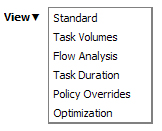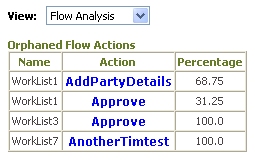
 Flow form
Flow form
Interacting with the Diagram tab

|

|
XXXXXXX Update for GRP-16027 View choice to see Discovery Map XXXXXXXXXXXXXXXX
C-1106 You can interact with the Diagram tab to
 To
work more easily with a large flow diagram, click the collapse arrow
(
To
work more easily with a large flow diagram, click the collapse arrow
(![]() ) in the portal to temporarily hide the navigation panel. When you
finish working with a large diagram, click the expand arrow (
) in the portal to temporarily hide the navigation panel. When you
finish working with a large diagram, click the expand arrow (![]() ) to redisplay the
navigation panel.
) to redisplay the
navigation panel.
Or, to hide the navigation panel automatically whenever you display a Flow form:
From the Diagram tab, you cannot alter the structure of the flow until you start Visio. You can create, review, or update rules and properties for most shapes.
shape review
paneltool (name TBD 5.5 GRP 202) . Select the
View tab to review the rules associated
with the shape. Select the Edit tab to
review the shape's property panel. Optimization option in the Views drop-down list. See About the Process Optimization tool.View menu to display a
summary report of task volumes, flow analysis, or task duration, or
to identify update properties linked to OnChange rules. ![]() Shape review
panel tool name TBD5.5 GRP-202
Shape review
panel tool name TBD5.5 GRP-202
When you right-click on specific shapes in the flow diagram, a shape review panel opens. This feature enables you to review and navigate to the rules, and to open the property panel settings associated with these shapes:
|
|
 ) to anchor it. The viewer
remains open in that position and does not move when you
right-click on another shape. Updates are applied each time you
switch shapes. To close the viewer, unpin it to display the
OK button or use the exit icon (
) to anchor it. The viewer
remains open in that position and does not move when you
right-click on another shape. Updates are applied each time you
switch shapes. To close the viewer, unpin it to display the
OK button or use the exit icon ( ).
). ![]() Views 5.4 proj-839
Views 5.4 proj-839
 Use the View drop-down list to display report overlays of
process throughput statistics, display a list of any orphaned
assignments or flow actions, and to identify flow actions subject to
policy overrides. See Understanding
policy overrides and suspended work objects.
Use the View drop-down list to display report overlays of
process throughput statistics, display a list of any orphaned
assignments or flow actions, and to identify flow actions subject to
policy overrides. See Understanding
policy overrides and suspended work objects.
Standard View is the default. Overlays and policy
override information are not displayed.
You can select the following report overlays: Proj-839 5.4

Task Volumes — Select to display the
current volume of work object assignments for each step in the
process. Those that are on time, past goal, and past deadline are
indicated as such. Click the link (total number) to open a list
view of the items comprising the assignment. You can also access
the Timeliness by Task summary report from the
Analyze Performance group within the
Monitor Activity workspace. The report includes a graphical
representation of the data for all the assignments in the
flow.
Flow Analysis — Select to
display the summary statistics describing the flow action path that
work objects have taken at each assignment. The percentages
displayed represent the actual usage patterns in the system and may
be used to benchmark and update the design-time percentages that
are defined when editing the flow. Click an action link to open a
summary view of the items comprising each assignment. You can open
a summary view for all the assignments in the flow by clicking
Flow
Analysis in the Design tab. You can also access the Action
Analysis summary report from the Analyze Performance group
within the
Monitor Activity workspace.
Task Duration — Select to display the
average time that an operator takes to process each of the
assignments in a flow. The duration appears in the HH:MM:SS
format. Click a link to open a summary view of the items comprising
each assignment. You can access the Task Duration
summary report from the Analyze Performance group within the
Monitor Activity workspace. The report includes a graphical
representation of the data for all the assignments in the
flow.Policy Overrides — Select this option
to identify those flow actions that include properties that are
linked to a declarative OnChange rule. Each such action is marked
with an OnChange button (
![]() If you have implemented the Process Optimization tool in your application,the
If you have implemented the Process Optimization tool in your application,the Optimization link displays. Click it to open the Optimization Criteria panel, which you use to
perform probability analysis on assignments in your process. See About the process optimization tool.
 Task
Volumes, Flow Analysis and Task Duration also display, under the
drop-down list, a table of orphaned assignments or flow actions that
may exist in the system but no longer have valid references as shown
in this example for Flow Analysis.
Task
Volumes, Flow Analysis and Task Duration also display, under the
drop-down list, a table of orphaned assignments or flow actions that
may exist in the system but no longer have valid references as shown
in this example for Flow Analysis.
These orphan items can occur when an assignment shape is missing or renamed through design or implementation errors, access issues, RuleSet issues, or database integrity issues. Click a link (Action item in this example) to open a list of orphan items. You can drill down to the item to correct the error. You can also delete an orphan assignment by opening the a flow error gadget, selecting an item, and clicking Delete Orphan Assignments .
Click once on a shape to display, in the bottom half of the workspace, a preview of the rule referenced by that shape. Previews may convey the runtime appearance of a work object form or other object.
Click the small open button (![]() ) at the top right of the preview area to open the
rule.
) at the top right of the preview area to open the
rule.
Shape |
When clicked, displays ... |
|
Assign |
The harness form preview, identifying the available flow actions. |
|
|
The decision rule referenced in the shape. |
|
Start |
For flow rules that have Creates a new work object? selected on the Process tab, the harness rule used to enter a new work object. |
|
Integrator |
The connector rule referenced in the shape. |
Router |
The name and a verbalization of the router activity. |
|
Spin-Off |
The flow form of the flow started by the spin-off shape. |
|
Split-ForEach |
The flow form for each flow rule. |
|
Utility |
The name and a verbalization of the activity referenced. |
![]() If you place a work object of an
appropriate work type on the clipboard before you preview, the
resulting harness form previews are more complete, as they contain
data from that work object.
If you place a work object of an
appropriate work type on the clipboard before you preview, the
resulting harness form previews are more complete, as they contain
data from that work object.
![]() Using the preview function for a harness,
section, or flow action rule may create a clipboard page and
initialize properties. In turn, this may execute declarative
processing. Use caution before implementing any on-change declarative
processing that updates a database. F-174 APAP SR-866 GROVS
10/11/05
Using the preview function for a harness,
section, or flow action rule may create a clipboard page and
initialize properties. In turn, this may execute declarative
processing. Use caution before implementing any on-change declarative
processing that updates a database. F-174 APAP SR-866 GROVS
10/11/05
![]() Double-click to
open, update, or create a rule
Double-click to
open, update, or create a rule
Double-click a shape to access the rule most directly associated with that shape. If the shape references a rule that does not exist, the New dialog box appears and you can create the missing rule.
Shape |
Double-click to open or create |
|
Assign |
The harness rule. |
|
|
The decision rule. |
|
Start |
For flow rules that have Creates a new work object? selected on the Process tab, the harness rule used to enter a new work object. |
|
|
The connector rule. |
|
Spin-off |
The flow rule to start. |
|
Split-ForEach |
The flow rule to iterate. |
|
Utility |
The utility activity. |
![]() Right-click to
identify or edit shape parameters
Right-click to
identify or edit shape parameters
Right-click a shape to open a pop-up window that lists rules
referenced in the shape properties. (To use the right-click feature,
first set the diagram to Standard View.) GRP-202
5.5
If the flow form is editable, you may edit the shape properties, from the View tab. This feature supports nine types of tasks: LAU_W 9/24/08
Shape |
For instructions, see |
|
Assign |
|
|
Assign Service |
|
|
Call or branch |
Flow rule — Editing the Call or Branch to Subflow shape properties |
|
|
|
|
Start |
|
|
Integrator |
|
|
Notify |
|
Router |
|
|
Spin-Off |
|
|
Split-ForEach |
|
|
Split/Join |
|
|
Utility |
![]() Interacting
with the Policy Overrides view
Interacting
with the Policy Overrides view
C-2117Select
Policy Overrides from the View menu to identify on the
diagram those flow actions that update property values that may start
OnChange rules.
Each ![]() shape marks a point in the flow
where a local flow action or connector flow action causes property
values to change that may in turn cause an OnChange rule to suspend
execution of this flow (for the current work object) or start an
additional flow. See:
shape marks a point in the flow
where a local flow action or connector flow action causes property
values to change that may in turn cause an OnChange rule to suspend
execution of this flow (for the current work object) or start an
additional flow. See: